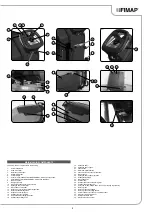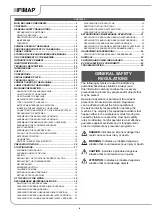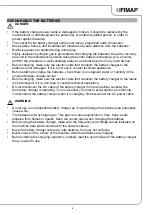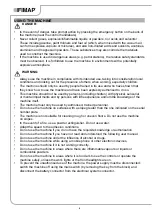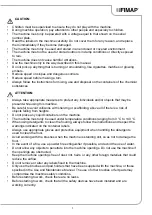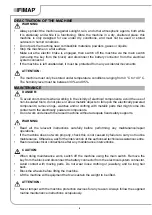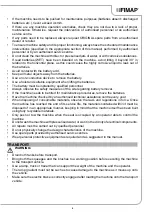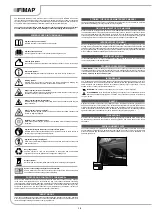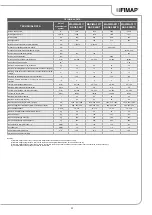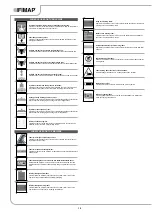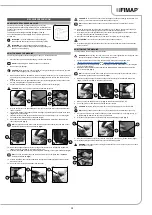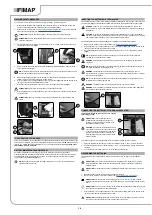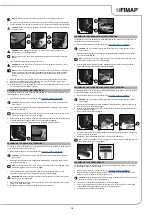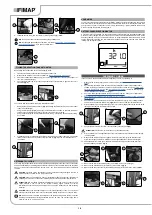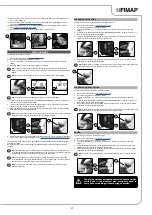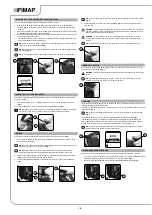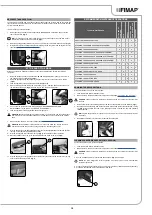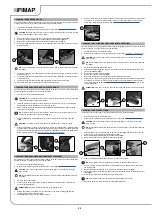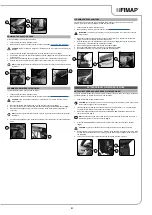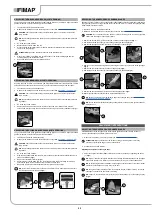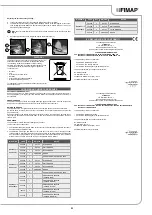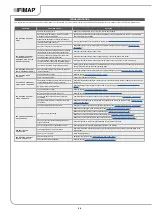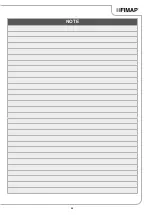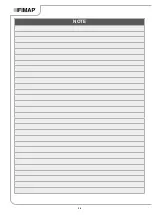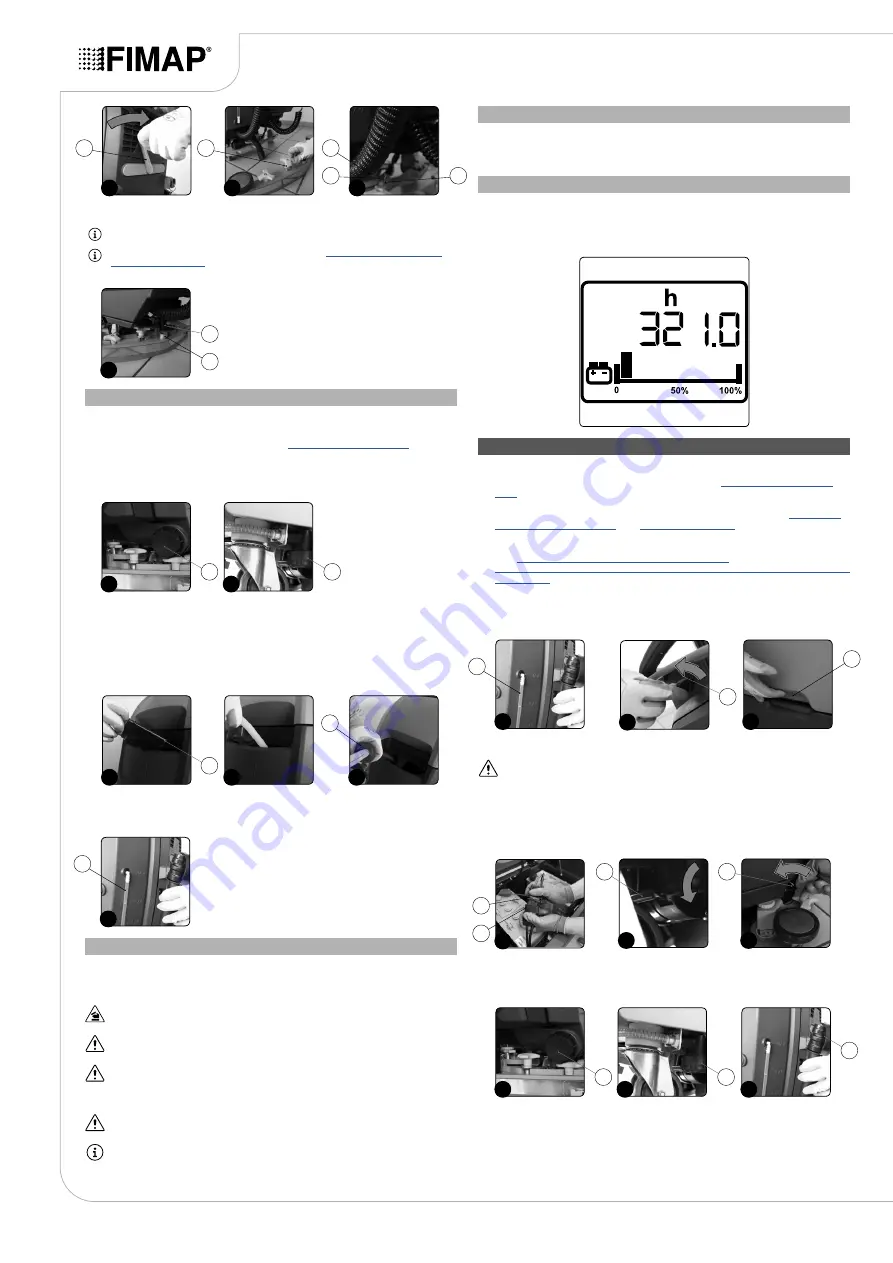
FILLING THE SOLUTION TANK WITH WATER
Before filling the solution tank, carry out the following steps:
1.
Take the machine to the usual place for filling the solution tank.
2. Make sure the machine is in a safe condition (see “
”).
3. Check the solution tank drainage cap (1) (on the rear right-hand side of the machine) is tight. If it
isn't, turn it clockwise (
Fig.1
).
4.
Check the water filter cap (2) (on the rear right-hand side of the machine) is tight. If it isn't, turn it
clockwise (
Fig.2
).
The solution tank can be filled with water in three different ways:
•
Removing the cap/measuring device (3) (
Fig.3
) and filling the solution tank by means of a rubber
tube or a bucket (
Fig.4
).
•
Using the filler tube (4) (
Fig.5
), which supports the water tube on its own. In this case, remember
to remove the cap/measuring device (3) to ensure the air is properly vented.
•
Using the optional system for automatic clean water top-up. This system has a float for avoiding
any overflow.
5. Fill with clean water, at a temperature not higher than 50°C and not lower than 10°C. The amount
inside the tank can be seen by means of the level tube (5) (
Fig.6
) on the rear left-hand side of
the machine.
DETERGENT SOLUTION
After filling the solution tank with clean water add the liquid detergent to the tank in the concentration
and manner indicated on the detergent manufacturer's label. To prevent the formation of an excessive
amount of foam that could damage the vacuum motor, use the minimum percentage of detergent
required.
CAUTION
: protective gloves should always be worn before handling detergents or acidic or
alkaline solutions, to avoid serious injury to the hands.
CAUTION
: always use detergents whose manufacturer's label indicates their suitability for
scrubbing machines. Do not use acid or alkaline products or solvents without this indication.
ATTENTION
: acid or alkaline maintenance detergents can be used, as long as they have pH
values between 4 and 10, and do not contain: oxidising agents, chlorine or bromine,
formaldehyde, mineral solvents. The detergents used must be suitable for use with scrubbing
machines.
CAUTION
: always use low-foam detergent. To avoid the production of foam, put a minimum
quantity of anti foam liquid in the recovery tank before starting to clean. Do not use pure acids.
NB
: to make it easier to measure the detergent on the cap/measuring device, there are notches
indicating the detergent percentage quantities that can be used. The notches range from a
minimum of 0.1% to a maximum of 0.5%.
HOUR METER
The machine control panel contains the control display, which shows the total usage time. The numbers
before the letter “h” identify the hours, while the numbers before the letter “m” identify the tenths of an
hour (a tenth of an hour corresponds to six minutes). The flashing “:” symbol indicates that the hour
meter is counting the machine functioning time.
On the lower part of the display, you can see the battery charge level. When the batteries fitted in the
machine are fully charged, the line at the bottom consists of nine illuminated indicator bars. As the
batteries gradually run down, the indicator bars are no longer illuminated. When the battery “critical
charge” threshold is reached, the last indicator bar flashes for about 20 seconds, after which the
“battery” symbol begins to flash.
BATTERY CHARGE LEVEL INDICATOR
In the case of a machine without FSS, before beginning to work it is necessary to:
1. Make sure the recovery tank is empty. If it isn't, empty it (see “
2. For versions without FSS, make sure the amount of detergent solution in the solution tank is
suitable for the type of work to be carried out. If it isn't, fill the solution tank (see "
"). Check the level tube (1) in
the rear left-hand part of the machine (
Fig.1
).
3. Check the rubber squeegee blades are in good working condition. If they aren't, replace them
(see “
REPLACING THE SQUEEGEE BODY RUBBER BLADES
4.
Check the brush is in good working condition. If it isn't, replace it (see “REPLACING THE BRUSH
5.
Check the machine is switched off. If it isn't, turn the main switch (2) to “0” by rotating the key a
quarter turn in the direction of the arrow (
Fig.2
). Remove the key from the instrument panel.
6. Grip the handle (3) on the right-hand side of the recovery tank (
Fig.3
) and turn the tank as far as
it will go, until it reaches the maintenance position.
PREPARING TO WORK
7. Connect the main system connector (4) to the battery connector (5) (
Fig.4
).
ATTENTION
: this process must be carried out by qualified personnel.
8. Grip the handle (3) on the right-hand side of the recovery tank and turn the tank until it reaches
the work position.
9. Make sure the electronic brake is engaged. If it isn't, turn the lever (6) in the direction of the
arrow. The traction gearmotor is located on the rear right-hand side of the machine (
Fig.5
).
10.
Check the water tap is fully open - the water adjustment knob (7) must be turned fully in the
direction shown by the arrow (
Fig.6
).
11. Make sure the solution tank drainage cap (8) is closed. If it isn't, close it (
Fig.7
).
12.
Make sure the water filter cap (9) is closed. If it isn't, close it (
Fig.8
).
13. Make sure the cap of the recovery tank drainage tube (10) is closed. If it isn't, close it (
Fig.9
).
6. Insert the vacuum tube (6) in the sleeve (7) in the squeegee body (
Fig.4
).
NB
: the tube must be positioned behind the squeegee lifting chain.
NB
: the squeegee has already been adjusted, but refer to “
” if you need any information.
16
4
7
6
2
1
1
2
4
3
6
5
3
4
5
1
1
2
2
3
3
5
6
6
7
4
4
5
8
9
7
8
9
10
2
3
1
1
2
4
3
5


